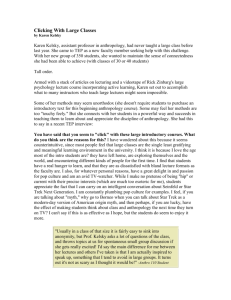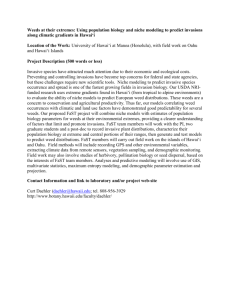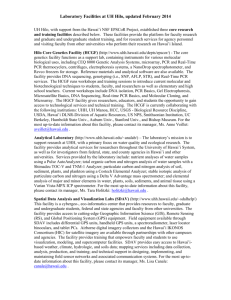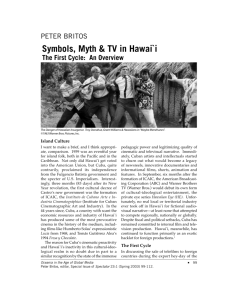Doc Format - Science in Hawaii Project
advertisement
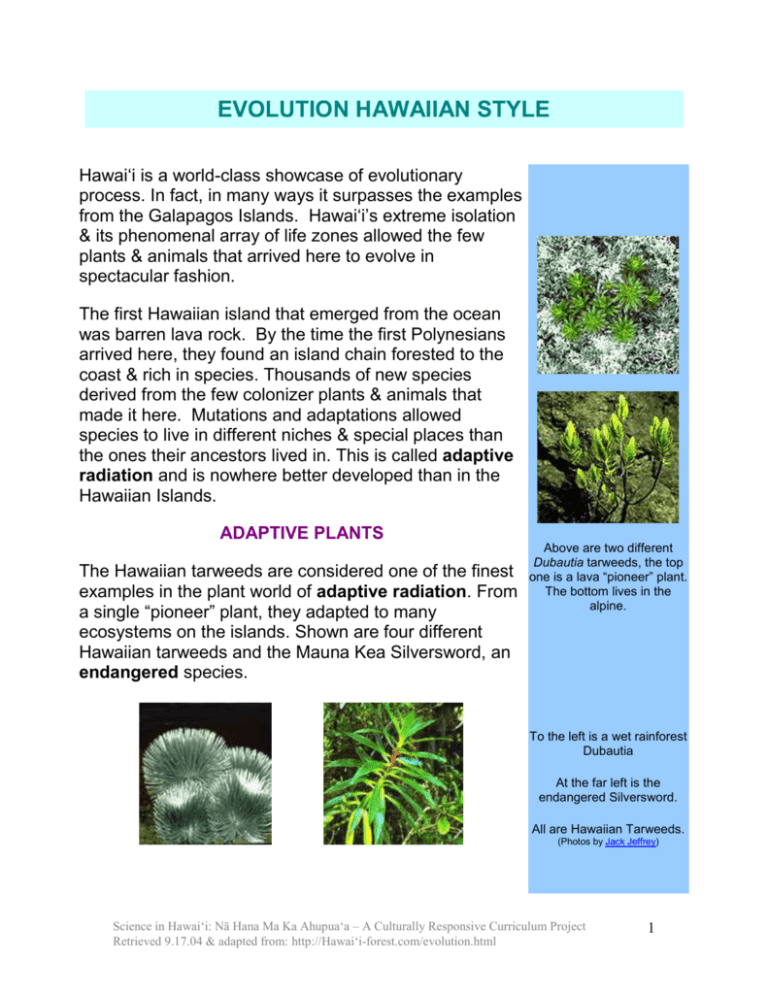
EVOLUTION HAWAIIAN STYLE Hawai‘i is a world-class showcase of evolutionary process. In fact, in many ways it surpasses the examples from the Galapagos Islands. Hawai‘i’s extreme isolation & its phenomenal array of life zones allowed the few plants & animals that arrived here to evolve in spectacular fashion. The first Hawaiian island that emerged from the ocean was barren lava rock. By the time the first Polynesians arrived here, they found an island chain forested to the coast & rich in species. Thousands of new species derived from the few colonizer plants & animals that made it here. Mutations and adaptations allowed species to live in different niches & special places than the ones their ancestors lived in. This is called adaptive radiation and is nowhere better developed than in the Hawaiian Islands. ADAPTIVE PLANTS The Hawaiian tarweeds are considered one of the finest examples in the plant world of adaptive radiation. From a single “pioneer” plant, they adapted to many ecosystems on the islands. Shown are four different Hawaiian tarweeds and the Mauna Kea Silversword, an endangered species. Above are two different Dubautia tarweeds, the top one is a lava “pioneer” plant. The bottom lives in the alpine. To the left is a wet rainforest Dubautia At the far left is the endangered Silversword. All are Hawaiian Tarweeds. (Photos by Jack Jeffrey) Science in Hawai‘i: Nā Hana Ma Ka Ahupua‘a – A Culturally Responsive Curriculum Project Retrieved 9.17.04 & adapted from: http://Hawai‘i-forest.com/evolution.html 1 ADAPTIVE INSECTS The Hawaiian Drosophila are a family of pomace flies that are believed to come from one colonization. Entomologists (bug scientists) estimate that there are a thousand species of Drosophila in Hawai‘i. They have been called ‘the world’s supreme example of evolutionary process.” At left is a flightless fly and a Picture-wing Drosophila in the grasp of a carnivorous caterpillar. Winged Drosophila A Fly that can’t fly? Carnivorous Caterpillars? Another recurring characteristic of Hawaiian evolution is dramatic changes or adaptive shifts. Flight is a tool for escape. If nothing is chasing you, there’s no need to fly. With the lack of predators in Hawai‘i, many species of flying insects and birds evolved to become flightless. In Hawai‘i many ecological niches were vacant. Nature hates a vacuum or ‘puka.’ Everywhere else in the world caterpillars eat plants. Filling a niche, a group of moths have made an evolutionary adaptive shift and have become “wait and capture” type predators of small insects, like mantids. They are the only known carnivorous caterpillars in the world. Carnivorous Caterpillar One of the most astounding examples of adaptive shifts in Hawai‘i occurs underground. Despite its young geologic age, over fifty species of cave adapted creatures, or, troglobytes, evolved here. With no light to see or sun to hide from, troglobytes evolve to lose their sight. Oftentimes the eyes disappear completely. Without the sun they also lose their pigmentation. At left is a Hawaiian blind cave cricket, first discovered in the early 1970s. It has lost both its vision and its pigmentation. One of our favorite evolutionary wonders is a tiny eightlegged creature. The Happy-Face Spider has colorful markings on its abdomen that bears an uncanny (Photos by Bill Mull) (Photos by Bill Mull) Cave Cricket (Photos by Bill Mull) Happy Face Spider (Photos by Bill Mull) Science in Hawai‘i: Nā Hana Ma Ka Ahupua‘a – A Culturally Responsive Curriculum Project Retrieved 9.17.04 & adapted from: http://Hawai‘i-forest.com/evolution.html 2 resemblance to a smiling human face. It’s found on the underside of specific plants in some Hawaiian rainforests. It is one of the few spiders known to take care of its young. Before humans came to Hawai‘i there were no large animals to eat plants. Mother Nature is very efficient. Defenses weren’t needed and over time were lost. For example, over one hundred different mints evolved here. The chemical that gives mints their mintiness is a defense – animals don’t like it. All Hawaiian mints lost the chemical: they’re Mint-less mints! Along with mintless mints, we have briar-less greenbriars, nettle-less nettles, sumac-less sumac, thorn-less raspberries, & spine-less hollies. Mint-less Mint (Photos by Bill Mull) ADAPTIVE ANIMALS Hawai‘i also has the best example of adaptive radiation in the bird world. The Hawaiian Honeycreepers, Drepanidinae, evolved from one finch like bird into an astonishing array of species. The original colonizer was probably a seedeater. Over millennia the birds adapted and co-evolved with plants for food sources. Of particular interest are the nectar feeders, such as I‘iwi or the extinct Akialoa, whose bills fit perfectly into long tubular flowers. Along with the nectar gatherers, the honeycreepers evolved into specialized feeders such as crossbills, creepers, warblers, a parrotbill, grosbeaks, and one bird, the Akiapōlā‘au, whose beak is both a woodpecker and a pry bar. Briar-less Greenbriar (Photos by Bill Mull) The painting to the right by Douglas Pratt shows representative beaks of the endemic Hawaiian Honeycreepers. Unfortunately these endemic Drepanids are also one of the most endangered families of birds on earth. Over a third of the original species are now extinct while another third are endangered. Science in Hawai‘i: Nā Hana Ma Ka Ahupua‘a – A Culturally Responsive Curriculum Project Retrieved 9.17.04 & adapted from: http://Hawai‘i-forest.com/evolution.html 3 CONSERVATION of HAWAIIAN FLORA & FAUNA Make a list of things people can do to protect the plants & animals of Hawai‘i. Major Threats: Pollution, Overexploitation, Physical alteration, Invasive species, Global Change (sea level, Climate). Science in Hawai‘i: Nā Hana Ma Ka Ahupua‘a – A Culturally Responsive Curriculum Project Retrieved 9.17.04 & adapted from: http://Hawai‘i-forest.com/evolution.html 4




